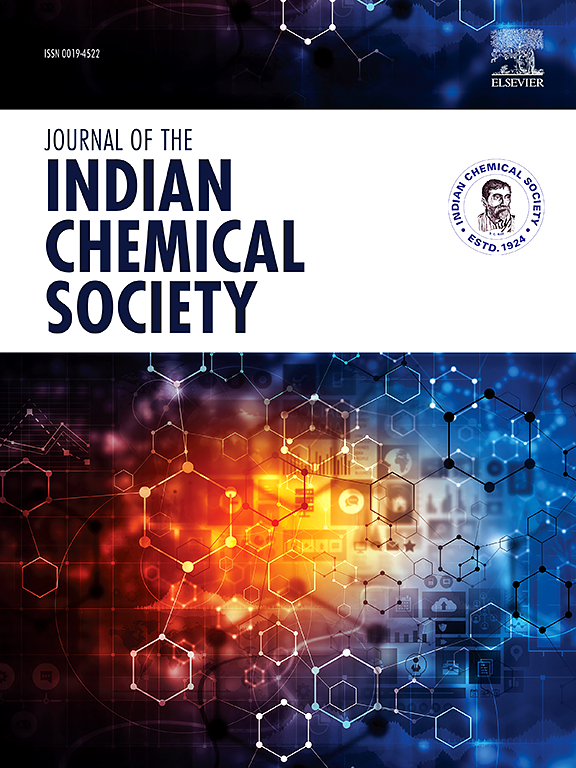氮化碳/瓜尔胶/氧化锌纳米复合材料对废水中有机污染物的高效催化去除
IF 3.2
4区 化学
Q2 CHEMISTRY, MULTIDISCIPLINARY
引用次数: 0
摘要
染料对水体的污染已成为一个环境问题,需要开发有效、持久的吸附剂。本文合成了g-C3N4/GG/ZnO纳米复合材料,并对其对刚果红(CR)染料的吸附性能进行了评价。采用FTIR、FESEM、XRD、HRTEM、BET、UV-Visible-DRS和XPS等分析仪器对改性后的纳米复合材料进行了表征。BET表面积分析显示,与单个组分相比,纳米复合材料的比表面积(43.302 m2/g)显著增加,这有助于增强染料吸附。紫外- drs分析显示,g-C3N4/GG/ZnO纳米复合材料的带隙能量为2.7 eV,证实了该材料的光学性质适合可见光吸收和光催化应用。采用ZnO和GG对g-C3N4进行改性,提高了g-C3N4的去除率(85.53±0.198 %)。g- c3n4 /GG/ZnO纳米复合材料在最佳剂量为2.4 g/L、接触时间为120 min的条件下,CR去除率达到97.76±0.08%。Langmuir模型是最有效的等温线模型,最大吸附量为52.6 mg/g。伪二阶模型与实验结果的相关性最好。在低用量、短反应时间下,该材料的吸附和光催化脱色效率达到94.89%。可重用性研究表明,纳米复合材料在三个循环中保持有效的吸附,尽管观察到性能逐渐下降。这些结果表明,g-C3N4/GG/ZnO纳米复合材料是一种高效的染料去除吸附剂,使其成为可持续废水处理应用的有希望的候选材料。本文章由计算机程序翻译,如有差异,请以英文原文为准。

Efficient catalytic removal of organic pollutant for wastewater treatment using a graphitic carbon nitride/guar-gum/ZnO nanocomposite
Water contamination from dyes has become an environmental concern, which calls for the development of effective and long-lasting adsorbents. In this work, g-C3N4/GG/ZnO nanocomposite was synthesized and its adsorption potential toward Congo red (CR) dye was assessed. Different analytical instruments such as FTIR, FESEM, XRD, HRTEM, BET, UV–Visible-DRS and XPS were used to characterize the modified nanocomposite. BET surface area analysis revealed a significant rise in the specific surface area (43.302 m2/g) of the nanocomposite compared to its individual components, which contributed to enhanced dye adsorption. UV-DRS analysis of g-C3N4/GG/ZnO nanocomposite showed a band gap energy of 2.7 eV, confirming the material's optical properties suitable for visible light absorption and potential photocatalytic applications. This study modified g-C3N4 with ZnO and GG to increase the removal efficiency of g-C3N4 (85.53 ± 0.198 %). The maximum CR removal of 97.76 ± 0.08 % was achieved by g-C3N4/GG/ZnO nanocomposite using an optimum dose of 2.4 g/L and 120 min contact time. The Langmuir model was identified as the most effective isotherm model, demonstrating the maximum adsorption capability of 52.6 mg/g. The pseudo-second-order model produced the best correlation with the experimental findings. The material was also evaluated for its adsorptive and photocatalytic dye removal efficiency under a low dosage and short reaction time, achieving a 94.89 % dye removal. Reusability studies revealed that the nanocomposite maintained effective adsorption over three cycles, although a gradual decrease in performance was observed. These results demonstrate that the g-C3N4/GG/ZnO nanocomposite is a highly effective adsorbent for dye removal, making it a promising candidate for sustainable wastewater treatment applications.
求助全文
通过发布文献求助,成功后即可免费获取论文全文。
去求助
来源期刊
CiteScore
3.50
自引率
7.70%
发文量
492
审稿时长
3-8 weeks
期刊介绍:
The Journal of the Indian Chemical Society publishes original, fundamental, theorical, experimental research work of highest quality in all areas of chemistry, biochemistry, medicinal chemistry, electrochemistry, agrochemistry, chemical engineering and technology, food chemistry, environmental chemistry, etc.

 求助内容:
求助内容: 应助结果提醒方式:
应助结果提醒方式:


